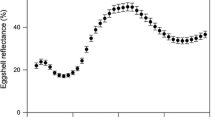Abstract
The capability of egg-guarding maleTridentiger kuroiwae brevispinis to defend their own nests and egg masses, measured experimentally by matching them with conspecific male competitors of various body size, was almost total against competitors of body lengths ≦104% of defending male body length. Against competitors with body lengths >116% of defending male body length, nest and egg defence almost always failed, indicating an upper limit of competitor's relative body size (between 104% and 116%) against which successful nest and egg-guarding is possible. The specific growth rate of egg-guarding males was significantly lower than that of non-egg-guarding males, due to starvation and stress. The results suggested that male body size has a major influence on guarding males' reproductive success, through post-spawning male-male competition.
Similar content being viewed by others
Literature Cited
Bisazza, A. and A. Marconato. 1988. Female mate choice, male-male competition and parental care in the river bullhead,Cottus gobio L. (Pisces, Cottidae). Anim. Behav., 36: 1352–1360.
Bisazza, A., A. Marconato and G. Marin. 1989. Male competition and female choice inPadiogobius martensi (Pisces, Gobiidae). Anim. Behav., 38: 406–413.
Brown, L. 1981. Patterns of female choice in mottled sculpins (Cottidae, Teleostei). Anim. Behav., 29: 375–382.
Downhower, J. F., L. Brown, R. Pederson and G. Staples. 1983. Sexual selection and sexual dimorphism in mottled sculpins. Evolution, 37: 96–103.
Emlen, S. and L. Oring. 1977. Ecology, sexual selection, and the evolution of mating systems. Science, 197: 215–223.
Enquist, M. and O. Leimar. 1987. Evolution of fighting behaviour: the effect of variation in resource value. J. Theor. Biol., 127: 187–205.
Goto, A. 1985. Individual identification by spine and ray clipping for freshwater sculpins. Japan. J. Ichthyol., 32: 359–362.
Goto, A. 1987. Polygyny in the river sculpin,Cottus hangiongensis (Pisces: Cottidae), with special reference to male mating success. Copeia, 1987: 32–40.
Goto, A. 1993. Male mating success and female mate choice in the river sculpin,Cottus nozawae (Cottidae). Env. Biol. Fish., 37: 347–353.
Hyatt, G. W. and M. Salmon. 1978. Combat in the fiddler crabUca pugilator andU. pugnax: a quantitative analysis. Behaviour, 65: 182–211.
Kaneko, T. and I. Hanyu. 1985. Annual reproductive cycle of the chichibu-gobyTridentiger obscurus. Bull. Jap. Soc. Sci. Fish., 51: 1645–1650.
Kishi, Y. 1979. Social behavior of the goby,Tridentiger obscurus. Hiyoshi Sci. Rev., Keio Univ., 15: 127–146. (In Japanese with English abstract.)
Maekawa, K., K. Iguchi and O. Katano. 1996. Reproductive success in male Japanese minnows,Pseudorasbora parva: observations under experimental conditions. Ichthyol. Res., 43: 257–266.
Magnhagen, C. and L. Kvarnemo. 1989. Big is better: the importance of size for reproductive success in malePomatoschistus minutus (Pisces, Gobiidae). J. Fish Biol., 35: 755–763.
Marconato, A. and A. Bisazza. 1988. Mate choice, egg cannibalism and reproductive success in the river bullhead,Cottus gobio L. J. Fish Biol., 33: 905–916.
Mashiko, K. and S. Yamane. 1993. Sexual dimorphism in the gobyTridentiger kuroiwae brevispinis. Japan. J. Ichthyol., 40: 363–368.
Mori, S. 1993. The breeding system of the three-spined stickleback,Gasterosteus aculeatus (forma leiurus) with reference to spatial and temporal patterns of nesting activity. Behaviour, 126: 97–124.
Mori, S. 1995. Factors associated with and fitness effects of nest-raiding in the three-spined stickleback,Gasterosteus aculeatus, in a natural situation. Behaviour, 132: 1011–1023.
Nakamura, N. 1942. Notes on the life history of a gobioid fish.Tridentiger obscurus. Doubutsu oyobi syokubutsu, 10: 7–11. (In Japanese).
Tinbergen, N. 1953. Social behaviour in animals. Methuen & Co. Ltd., London, 150 pp.
Wootton, R. L. 1990. Ecology of teleost fishes. Chapman & Hall, London. 404 pp.
Author information
Authors and Affiliations
About this article
Cite this article
Mashiko, K. Defensive capability of egg-guarding males of the goby,tridentiger kuroiwae brevispinis . Ichthyological Research 45, 135–139 (1998). https://doi.org/10.1007/BF02678555
Received:
Revised:
Accepted:
Issue Date:
DOI: https://doi.org/10.1007/BF02678555




